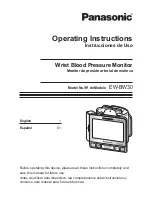
English-18
Features
Lightweight Design:
The design of the display, including a remarkably thin bezel and minimal stand components, promotes
lightweight for easier portability and desktop maneuvering.
Human Sensor:
Shifts to a lower power consumption level when a person leaves the monitor, saving your monitor energy costs.
Touch Key / Slide key:
Allows you to quickly and easily adjust all elements of your screen image by simply sliding your finger
over the icons on the monitor bezel.
Redesigned OSD controls
allow you to quickly and easily adjust all elements of your screen image.
Quick Release stand:
Allows fast removal for good mobility and multi display setting.
Height-adjustable (110 mm) stand with tilt, swivel and pivot
add flexibility to your viewing preferences.
USB Pass-through:
Adds excitement to your computing by connecting you to web cameras, USB memory and more.
Simple MENU:
Allows you to quickly and easily access basic OSD controls. A broad assortment of advanced adjustments are
also available via the Full OSD Menu.
No Touch Auto Adjust
automatically adjusts your optimal image settings upon initial power-on.
Color Control Systems:
Allows you to adjust the colors on your screen and customize the color accuracy of your monitor to a
variety of standards.
NaViSet software
offers an expanded and intuitive graphical interface, allowing you to more easily adjust OSD display settings
via mouse and keyboard.
The flat screen’s crisp, bright images and crystal-clear text
deliver a comfortable viewing experience.
ErgoDesign Features:
Enhance human ergonomics to improve the working environment and protect your health. Examples
include OSD controls for quick and easy image adjustments, tilt base for preferred viewing angle, small footprint and compliance
with MPRII and TCO guidelines for lower emissions.
Plug and Play:
The Microsoft
®
solution with the Windows
®
operating system facilitates setup and installation by allowing the
monitor to send its capabilities (such as screen size and resolutions supported) directly to your computer, automatically
optimizing display performance.
IPM (Intelligent Power Manager) System:
Provides innovative power-saving methods that allow the monitor to shift to a lower
power consumption level when on but not in use, saving two-thirds of your monitor energy costs, reducing emissions and
lowering the air conditioning costs of the workplace.
Multiple Frequency Technology:
Automatically adjusts the monitor to the display card’s scanning frequency, thus displaying
the resolution required.
FullScan Capability:
Allows you to use the entire screen area in most resolutions, significantly expanding image size.
VESA Standard Mounting Interface:
Allows you to connect your monitor to any VESA standard third party mounting arm or
bracket.
Environmental Impact (EX231W):
Annual typical maximum operating carbon footprint of this monitor (world-wide average) is
approximately 28.2 kg (calculated by: rated wattage x 8 hours per day x 5 days a week x 45 weeks per year x Power-to-
Carbon conversion factor - conversion factor is based on OECD publication of global CO2 emissions 2008 Edition).
This monitor has a manufacturing carbon footprint of approximately 13.1 kg.
Note:
The manufacturing and operating carbon footprints are calculated by a unique algorithm developed exclusively by NEC
for its monitors.
Environmental Impact (EX231Wp):
Annual typical maximum operating carbon footprint of this monitor (world-wide average)
is approximately 24.5 kg (calculated by: rated wattage x 8 hours per day x 5 days a week x 45 weeks per year x Power-to-
Carbon conversion factor - conversion factor is based on OECD publication of global CO2 emissions 2008 Edition).
This monitor has a manufacturing carbon footprint of approximately 13.9 kg.
Note:
The manufacturing and operating carbon footprints are calculated by a unique algorithm developed exclusively by NEC
for its monitors.
HDCP (High-bandwidth Digital Content Protection):
HDCP is a system for preventing illegal copying of video data sent over
a Digital Visual Interface (DVI). If you are unable to view material via the DVI input, this does not necessarily mean the display is
not functioning properly. With the implementation of HDCP, there may be cases in which certain content is protected with HDCP
and might not be displayed due to the decision/intention of the HDCP community (Digital Content Protection, LLC).





































